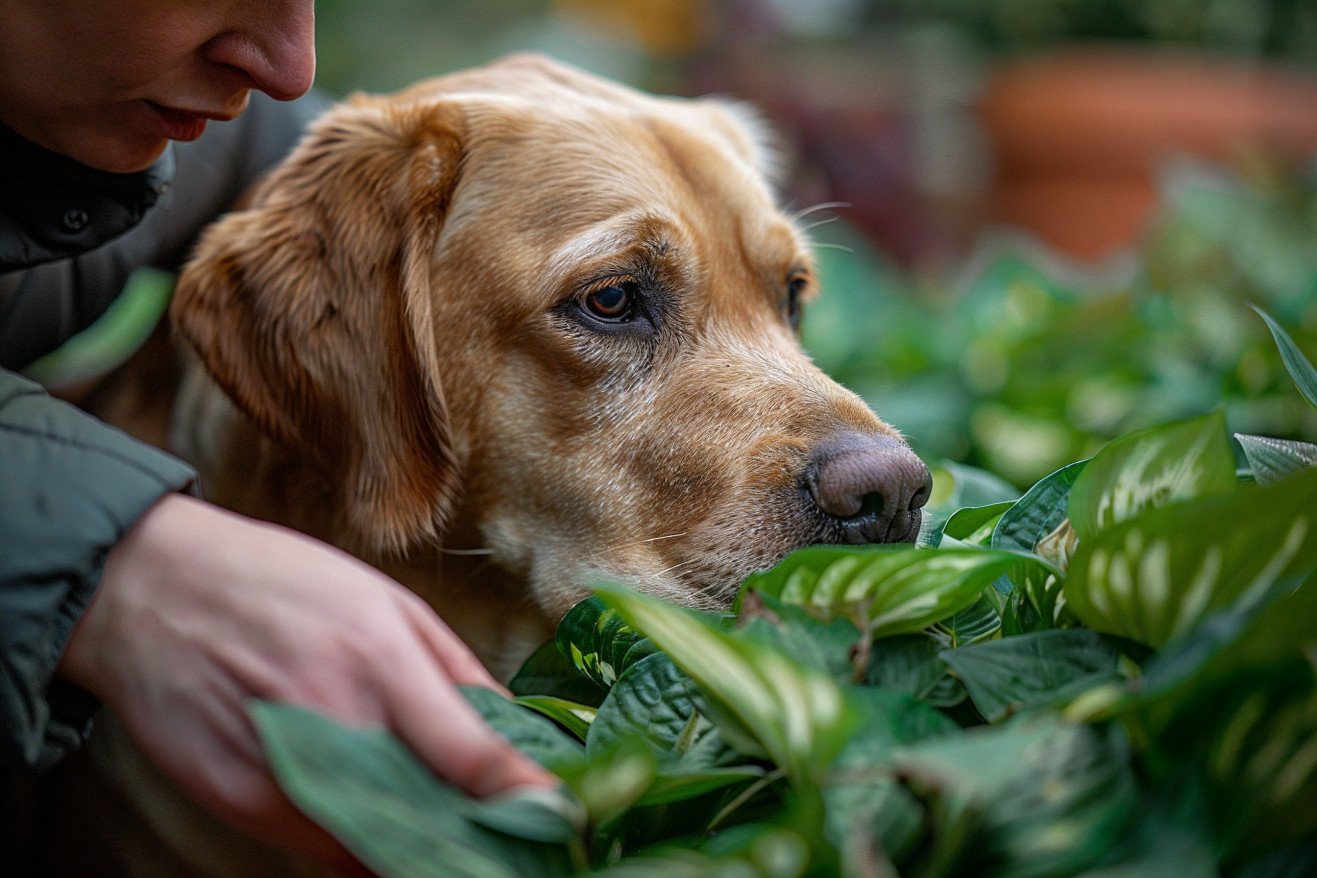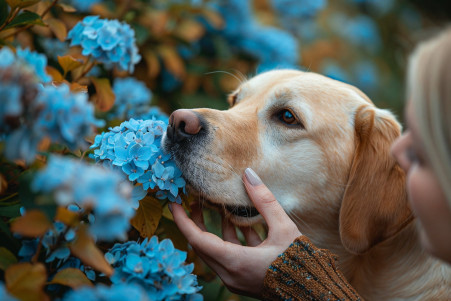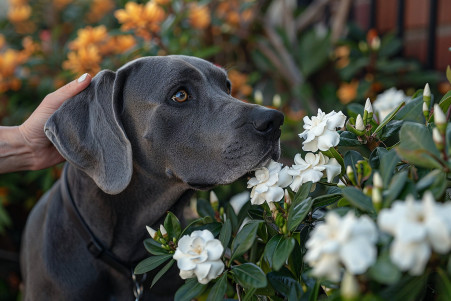Can Dogs Eat Hostas? Everything You Need to Know
17 April 2024 • Updated 15 April 2024

If you have a dog and a garden, you may have asked yourself whether or not the hostas growing in your yard are safe for your pet to be around. Hostas are toxic to dogs and can cause a range of symptoms, including vomiting, diarrhea, and hemolytic anemia, if they are eaten, so it's important to make sure your dog can't access them.
In this article, we'll cover the topic in detail, drawing on the expertise of veterinary toxicologists, horticulturists, and other animal care professionals to give you a thorough understanding of the risks that hostas present to dogs. Not only will this information help you better understand the potential dangers, but we'll also share some tips to help you ensure your dog's well-being while still enjoying these popular plants in your garden.
Are hostas poisonous to dogs?
Signs and Side Effects of Hosta Poisoning in Dogs
The symptoms of hosta poisoning in dogs can range from mild stomach upset to life-threatening side effects. According to a study referenced by WagWalking, the most common symptoms include vomiting, diarrhea, lethargy, drooling, loss of appetite, and abdominal pain. While these symptoms may be easy to brush off at first, it's important to take them seriously.
In less severe cases, dogs may experience some changes in behavior or mild stomach issues after consuming a small amount of hosta. However, more severe symptoms can quickly develop, leading to persistent vomiting and diarrhea or even difficulty breathing, as noted by the Greg.app article. The severity of the symptoms often depends on the amount of hosta the dog has consumed in relation to their body weight.
Dehydration is a major concern when vomiting and diarrhea are present and can lead to life-threatening complications if it's not addressed. As the NIH article points out, the saponins in hostas can lead to red blood cell damage and gastrointestinal irritation, which can make dehydration and electrolyte imbalances worse. It's important to watch for signs of dehydration, including sunken eyes, dry gums, and lethargy, as it may be necessary to seek veterinary care to help the dog get rehydrated.
First-Aid and Veterinary Treatment for Hosta Ingestion
If you think your dog has eaten a hosta plant, make sure to remove any remaining plant material from their mouth and give them water right away. As per the Cornell University College of Veterinary Medicine, call your vet or an animal poison control hotline immediately and be prepared to tell them the type and amount of plant your dog ate and describe any symptoms they are experiencing.
Veterinary treatment can include decontamination, IV fluids, and medications to help with symptoms such as vomiting and diarrhea. Based on the details from Greg.app, it's important to make sure you're following your vet's instructions, including any advice on how to watch over your dog and care for them while they recover.
Assessing the Risks: Toxicity Levels and Plant Parts
Saponins are present in all parts of the hosta plant, including the leaves, flowers, and roots, and this is why all parts of the plant are considered toxic to dogs, according to Reader's Digest. While even small amounts of the plant can cause symptoms and require veterinary treatment, the toxicity of the situation will often depend on the amount of the plant in relation to the dog's size.
As the details on Greg.app point out, larger dogs may be able to handle small amounts of the plant with only minor symptoms, but smaller dogs and puppies are more likely to experience severe symptoms. That said, it's also true that eating larger amounts of the plant, especially the roots, can lead to more severe toxicity in dogs of any size, as a vet explains on JustAnswer.
How to Avoid Hosta Poisoning: Tips for Dog Owners
The most effective way to avoid hosta poisoning is to not plant hostas in places where dogs can get to them or to keep potted hostas in places that are out of reach, as suggested by Canine Country. If you already have hostas, you can also try fencing off parts of your garden, using motion-activated repellents, or using positive reinforcement to train dogs to stay away from the plants.
It's also important to regularly check outdoor spaces for any fallen leaves or other plant debris that dogs could eat, as noted by the information on BetterPet. For indoor plants, you can avoid problems by keeping them out of reach or using pet-proof barriers to keep dogs from getting to them and eating them.
By taking steps to limit the access dogs have to hostas, you can lower the chances of poisoning and keep your pet safe. If you're a dog owner who still wants to have a beautiful garden, the next section will cover some plants that are safe for dogs and can be used as alternatives to hostas.
Dog-Friendly Gardening: What to Plant Instead of Hostas
For dog owners who still want to enjoy a lovely garden but don't want to take the risk of planting hostas, there are many dog-friendly plants to choose from. According to the Rover.com article, some options to consider are camellia, dill, marigold, fuchsias, magnolia bushes, purple basil, and a variety of ferns and palms.
However, it's important to make sure you always check the specific variety of the plant and look at reliable sources like the BetterPet guide to make sure that the plant you're considering is safe for dogs. The Great Garden Plants blog also recommends catmint as a dog-friendly perennial that blooms for a long time and can handle a little bit of disruption from dogs.
In addition, you can also protect your plants and your pets in a shared outdoor space by creating dog-free areas or using physical barriers, as suggested by Canine Country. By choosing and arranging dog-friendly plants carefully, you can have a beautiful, green garden that's safe for your dog.
Conclusion: How to Keep Your Landscaping Safe for Pets
Although hostas are beautiful and popular plants for landscaping, their toxic saponin content makes them a danger to dogs. Ingesting any part of the hosta plant can cause vomiting, diarrhea, and other issues, and these problems can be especially severe if a small dog eats a large amount of the plant.
Dog owners can take steps to prevent hosta poisoning by removing hostas from their yards, using barriers to keep their dogs away from the plants, and looking for dog-safe alternatives to hostas. If a dog does eat a hosta, it's important to get them to a vet as soon as possible so that they can be treated for their symptoms and make a full recovery.
By making sure that their landscaping is safe for their pets, dog owners can create a beautiful and healthy garden that won't put their dogs at risk.


